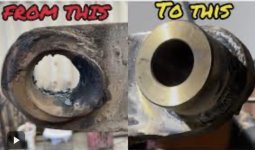When loaders (FEL) were first made most were very crude pieces. Some were mounted on the back of a tractor, some were mounted on the front with cylinders and cables to lift them, some were mounted on a tractor and basically that was all the tractor could be used for. Most of these has lift only with no down pressure and a manual trip bucket and the buckets were very narrow. Many after market manufacturers sprung up and when their gadgets failed they disappeared.
Most agriculture companies then started building Manure Loaders these were built for of course loading manure into a spreader, handling grain, fertilizer, snow and other light jobs around the farm. Most should not be used for earth moving as they were light construction and would break, bend, or fail. Even today they are still no meant for digging. Most of the time you can tell by how they are mounted. Are the frames heavy, are they full length of the tractor, or are they bolted to weak parts of the frame, do they take the stress off the tractor frame?
Construction equipment manufacturers found these to light for digging and companies started building heavier frame loaders that mounted under the rear axle and solidly on the front of the tractor. Some manufacturers made the loader and tractor as a package to get the strength required for digging and lifting heavy loads of soil high enough to put it on a truck. Get a chance go look at one, notice most now are built as a complete package and frames are heavy and strong. Most will have enough force to lift the tractor high off the ground.
Now with that said I'm not saying most "homeowner" grade loaders can't dig in the earth, but you are risking broken frames, mounts, and possible damage to the tractor to do so.
A backhoe is a specialized tool made for digging trenches. Again there are "homeowner" grade and industrial grade. A small one can do the job usually if the soil isn't too hard, but it will take longer to do the same job.
An example of that years ago our neighbor had a water line leaking and wanted to replace it. He called my father who took a JD 400 with a Brantly backhoe and attempted to dig up the pipe. A few hours later, after barely scratching the surface, he called me and asked if I could borrow a 580 Case TBL. I went over which took longer than digging the pipe out.
So in summing it all up go ahead it is your tractor, your investment, Use it as you see fit but when and if it fails don't blame the manufacturer for building a poor product unless they stated it can be used for excavation.


